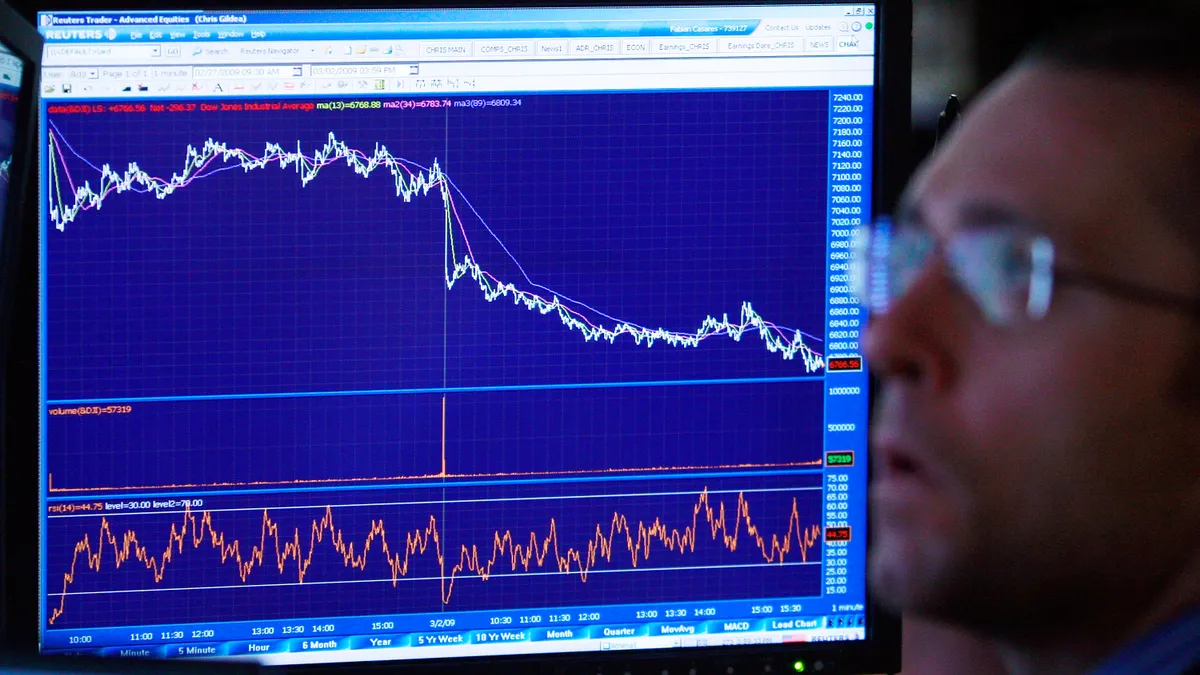Dive Brief:
- A slump in credit will probably trigger recession, clouding a business outlook already dimmed by high inflation, rising interest rates and geopolitical instability, according to respondents to a survey by the International Association of Credit Portfolio Managers.
- Nearly nine out of 10 finance executives (86%) believe defaults will rise in North America during the next 12 months, and “a large majority of respondents expect global economies to fall into recession sometime in the foreseeable future,” the IACPM said.
- “Banks, especially regional ones, are not only looking at their deposit bases and whether their depositors will stick around, but they’re also hearing from regulators calling for higher levels of liquidity at their institutions,” IACPM Executive Director Som-lok Leung said in a statement. “Banks will do what they have to do to preserve capital, and one way to do that is to make fewer loans.”
Dive Insight:
Federal Reserve economists, citing banking system turmoil, discarded their December forecast for sustained economic growth and advised policymakers that a downturn is likely to begin later this year, according to minutes of a March 21-22 meeting released Wednesday.
“Given their assessment of the potential economic effects of the recent banking-sector developments, the staff's projection at the time of the March meeting included a mild recession starting later this year, with a recovery over the subsequent two years,” according to the minutes.
Policymakers during the past year have tried to slow growth, cool the labor market and curb inflation by raising the federal funds rate from near zero to a range between 4.75% and 5%.
Fed Chair Jerome Powell and several other central bankers have said in recent weeks that a credit pullback caused by turbulence in the banking system may reinforce their fight against inflation.
“Tighter financial conditions or other lending conditions would likely cause households to reduce spending and businesses to pull back on investment and hiring, all of which will help move supply and demand back into better balance and help bring inflation down toward our 2% target,” Fed Governor Christopher Waller said Friday.
“It is important to note that there were indications of tightening credit conditions this year before the problems emerged in the banking system,” Waller said in a speech.
The economy showed some signs of slowing last month. Retail sales fell 1% in March, the second straight month of a pullback, the Commerce Department said Friday, while manufacturing output decreased 0.5%.
Still, “consumers and businesses are showing remarkable resilience,” Waller said, noting estimates by the Atlanta Fed that the economy grew at a 2.2% annual rate during the first quarter.
“This growth would mean that, so far, tighter monetary policy and credit conditions are not doing much to restrain aggregate demand,” he said.
The central bank, while reducing some measures of inflation since mid-2022, has not made steady progress in restoring inflation to its 2% target.
Core inflation excluding food and energy, a gauge of underlying price pressure, rose 5.6% last month on an annualized basis compared with 5.5% in February, fueling expectations that the Fed will raise the main interest rate by a quarter percentage point in early May.
“It was the fourth month in a row with core inflation at 0.4% or higher,” Waller said, adding “since December of 2021 core inflation has basically moved sideways with no apparent downward movement.”
“Monetary policy needs to be tightened further,” he said. It “will need to remain tight for a substantial period of time, and longer than markets anticipate.”
Investors on Friday set 79% odds that the Fed will hike the main interest rate by 0.25 percentage point at its scheduled May 2-3 meeting, according to the CME FedWatch Tool.
On April 5, before recent reports on inflation and the labor market, investors saw just 43% odds of a quarter-point increase and a 57% probability of no change, according to CME, which calculates expectations based on trading in interest-rate futures markets.
Healthcare, defense, transportation and medium-sized technology companies will likely feel the most strain from tightening credit, according to the IACPM, which includes 130 financial institutions in 30 countries, including banks, insurance companies and asset managers.
“Commercial real estate may be particularly vulnerable,” the association said. “Large numbers of office workers continue to work from home, putting pressure on office occupancy rates, while many property owners will eventually have to refinance in a less accommodating banking environment.”












